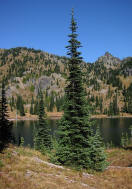Habitat and Geography
Grizzly bears live in mountainous regions throughout North
America. Female
grizzly bears have a home range between 50 to 300 square miles
and males have a home range between 200 to 500 square miles
(U.S. Department of the Interior, 1995). Scientists have divided
grizzly bear habitats into three different climatic zones.
Those zones are the
alpine, subalpine, and temperate.
These zones are based on the altitudes at which grizzly
bears live (Murray, 1995).
Alpine Zone
The alpine zone of a mountain is the area
above the tree line. Once all of
the snow has melted from the past winter, usually early summer, the alpine
zone provides the bears with plants such as horsetail, grasses, spring
beauty, and
blueberries. Most of
the plants found in this zone are perennials and have adapted to a very
short growing season. They
flower and disperse seeds in a very short amount of time during the summer.
Other plant species eaten by grizzly bears also begin to appear, as
the days grow warmer. Many other
animal species such as
moose, elk, deer, and small land mammals use the
alpine zone during the summer months.
These animals like to use the alpine zone as birthing grounds so the
bears have an easy meal if they stumble upon a newborn
elk,
deer, or moose
(Murray, 1995). These animal
species are a main food source for grizzly bears, especially during the fall
when grizzly bears are trying to gain as much fat as they can for their
winter hibernation. Recently,
grizzly bears have been shown to use this zone more often than usual due to
conflicts with humans (Stewart et. al., 2012).
In arctic areas, usually north of the Arctic Circle, grizzly bears
spend their time year round in the alpine zone.
The alpine zone is a popular denning area for bears because of how
hard some of the dens are to get to.
It provides security for the bears. (Murray, 1995).
Subalpine Zone
The subalpine zone is an area
that is dominated by thick forests and open clearings, below the alpine zone and above the temperate zone.
This zone is home to whitebark pine and subalpine fir groves.
This is a very cool and moist zone, which is perfect for growing
blueberries,
rasberries, blackberries, and huckleberries.
Another food source for bears in this zone is the nut of the whitebark pine.
Grizzly bears spend their time here in the summer and early fall
months, mainly when berries are ripe.
There are also streams that run through this zone so the bears eat
trout that call the streams their home.
Since this zone has a lot of thick forests, bears will tear apart
rotten logs and eat the insects inside.
They will also eat elk, moose, and small mammals that live in the
subalpine zone. Any
the alpine zone and above the temperate zone.
This zone is home to whitebark pine and subalpine fir groves.
This is a very cool and moist zone, which is perfect for growing
blueberries,
rasberries, blackberries, and huckleberries.
Another food source for bears in this zone is the nut of the whitebark pine.
Grizzly bears spend their time here in the summer and early fall
months, mainly when berries are ripe.
There are also streams that run through this zone so the bears eat
trout that call the streams their home.
Since this zone has a lot of thick forests, bears will tear apart
rotten logs and eat the insects inside.
They will also eat elk, moose, and small mammals that live in the
subalpine zone. Any
Temperate Zone
The temperate zone is the zone you first
see when you get close to mountainous regions.
It consists of lowland areas such as foothills and valley floors.
These areas are generally dry and have grassy vegetation, compared to
the other two zones. This zone
also has woodlands and conifer groves.
Grizzly bears can be found in this zone from the early spring to late
autumn. Grizzly bears rarely
ever hibernate in the temperate zone. Snow melts first in the temperate
zone, providing some of the first food for bears as they begin to come out
of hibernation. Some food
sources that are available in this zone are dead animals, small mammals,
insects, grass, moose, elk, and roots of plants such as spring beauty and
peavine. This zone is also home
to a lot of big rivers. When the
salmon run is in progress, you can find many bears next to these rivers
gorging themselves on fresh salmon (Murray, 1995).